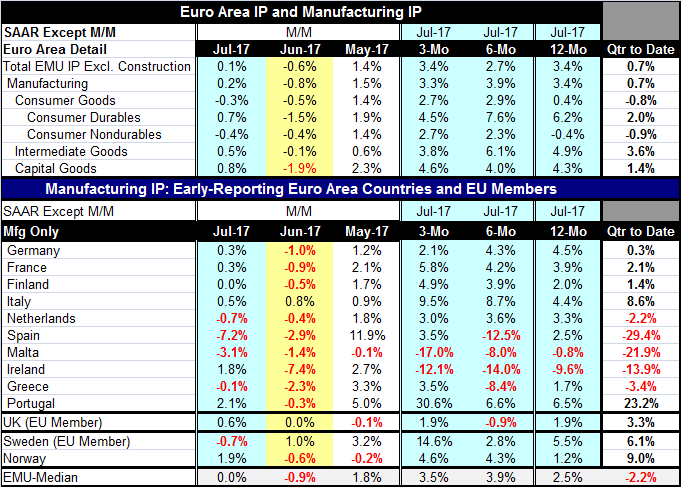 Global| Sep 13 2017
Global| Sep 13 2017EMU IP Ticks Higher and Holds to Solid Growth Path
Summary
EMU industrial production growth is in a range of 2.7% to 3.4% on its sequential annualized growth rates over three months to six months to 12 months; that is a pretty solid habitat. For manufacturing, the range is 3.3% to 3.9%, even [...]
 EMU industrial production growth is in a range of 2.7% to 3.4% on its sequential annualized growth rates over three months to six months to 12 months; that is a pretty solid habitat. For manufacturing, the range is 3.3% to 3.9%, even better. There is no acceleration in gear based on growth progression, but there is a real pro-growth signal in the growth pattern for IP by sector. Durable consumer goods output growth is in an elevated range from 4.5% to 7.6%, much higher than for other components. Nondurables output is in a range from -0.4% to +2.7% and it is showing steady acceleration. Nondurables indicate that output recovery is still in an 'early phase' as year-over-year output is still shrinking. Intermediate goods output growth is ranging from 3.8% to 6.1%, a solid habitat. Capital goods output is expanding at a relatively strong pace. in a range from 4% to 4.6%.
EMU industrial production growth is in a range of 2.7% to 3.4% on its sequential annualized growth rates over three months to six months to 12 months; that is a pretty solid habitat. For manufacturing, the range is 3.3% to 3.9%, even better. There is no acceleration in gear based on growth progression, but there is a real pro-growth signal in the growth pattern for IP by sector. Durable consumer goods output growth is in an elevated range from 4.5% to 7.6%, much higher than for other components. Nondurables output is in a range from -0.4% to +2.7% and it is showing steady acceleration. Nondurables indicate that output recovery is still in an 'early phase' as year-over-year output is still shrinking. Intermediate goods output growth is ranging from 3.8% to 6.1%, a solid habitat. Capital goods output is expanding at a relatively strong pace. in a range from 4% to 4.6%.
By country
For relatively early reporting countries in the EMU, IP is lower in July in only four of ten countries after seeing declines in nine of ten in the prior month. Germany and Malta show sequentially slowing rates of IP growth from 12-month to six-month to three-month. France, Finland, Italy and Portugal show sequentially accelerating rates of growth.
In the quarter-to-date
The Netherlands, Malta, Spain, Ireland and Greece are showing declines in output early in the quarter. Italy and Portugal are showing strong advances; France and Finland are showing moderate expansions; Germany is posting a bare-bones gain at a 0.3% annualized rate of growth
Overall EMU IP is advancing at a 0.7% annual rate in Q3 compared to its Q2 level of output.
Summing up
The relatively sharp drop in output in June followed by a weak July rebound has taken a lot of momentum away from manufacturing IP across countries. May had seen a larger gain than the June drop. However, despite the IP drop in June and the weak rebound in July, the three-month growth rates stand up quite well. Only Malta and Ireland have negative rates of growth over three months. Apart from them, only Germany has a three-month rate of growth less than 3%. For the most part, the growth rate data show still very solid progress and the IP and PMI surveys are in solid alignment as well. The ECB is going to be scrutinizing all these reports as it prepares to pull back on its stimulus. IP is looking solid enough to let the ECB do just that if it thinks the time is ripe. Inflation is still below target, but German inflation posted a four-month high with its core pace up to 1.6%. There is probably enough EMU inflation and growth progress together to allow the ECB to begin to dismantle some of its aggressive stimulus structure soon.

Robert Brusca
AuthorMore in Author Profile »Robert A. Brusca is Chief Economist of Fact and Opinion Economics, a consulting firm he founded in Manhattan. He has been an economist on Wall Street for over 25 years. He has visited central banking and large institutional clients in over 30 countries in his career as an economist. Mr. Brusca was a Divisional Research Chief at the Federal Reserve Bank of NY (Chief of the International Financial markets Division), a Fed Watcher at Irving Trust and Chief Economist at Nikko Securities International. He is widely quoted and appears in various media. Mr. Brusca holds an MA and Ph.D. in economics from Michigan State University and a BA in Economics from the University of Michigan. His research pursues his strong interests in non aligned policy economics as well as international economics. FAO Economics’ research targets investors to assist them in making better investment decisions in stocks, bonds and in a variety of international assets. The company does not manage money and has no conflicts in giving economic advice.






